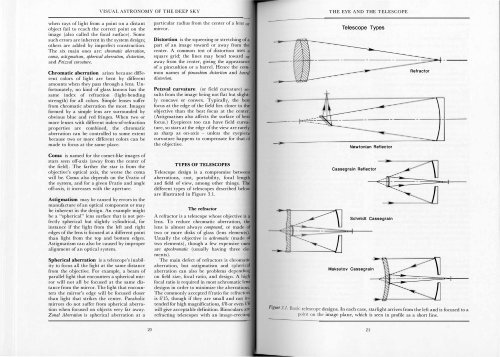OF THE ROGER N. CLARK
OF THE ROGER N. CLARK
OF THE ROGER N. CLARK
You also want an ePaper? Increase the reach of your titles
YUMPU automatically turns print PDFs into web optimized ePapers that Google loves.
VISUAL ASTRONOMY <strong>OF</strong> <strong>THE</strong> DEEP SKY<br />
<strong>THE</strong> EYE AND <strong>THE</strong> TELESCOPE<br />
when rays of light from a point on a distant<br />
object fail to reach the correct point on the<br />
image (also called the focal surface). Some<br />
such errors are inherent in the system design;<br />
others are added by imperfect construction.<br />
The six main ones are: chromatic aberration,<br />
coma, astigmatism, spherical aberration, distortion,<br />
and Pet::;val curvature.<br />
Chromatic aberration arises because different<br />
colors of light are bent by different<br />
amounts when they pass through a lens. Unfortunately,<br />
no kind of glass known has the<br />
same index of refraction (light-bending<br />
strength) for all colors. Simple lenses suffer<br />
from chromatic aberration the most. Images<br />
formed by a simple lens are surrounded by<br />
obvious blue and red fringes. When two or<br />
more lenses with different index-of-refraction<br />
properties are combined, the chromatic<br />
aberration can be controlled to some extent<br />
because two or more different colors can be<br />
made to focus at the same place.<br />
particular radius from the center of a lens or<br />
mirror.<br />
Distortion is the squeezing or stretching of a<br />
part of an image toward or away from the<br />
center. A common test of distortion uses a<br />
square grid; the lines may bend toward or<br />
away from the center, giving the appearance<br />
of a pincushion or a barrel. Hence the common<br />
names of pincushion distortion and barrel<br />
distortion.<br />
Petzval curvature (or field curvature) results<br />
from the image being not flat but slightly<br />
concave or convex. Typically, the best<br />
focus at the edge of the field lies closer to the<br />
objective than the best focus at the center.<br />
(Astigmatism also affects the surface of best<br />
focus.) Eyepieces too can have field curvature,<br />
so stars at the edge of the view are rarely<br />
as sharp as on-axis - unless the eyepiece<br />
curvature happens to compensate for that<br />
the objective.<br />
Te lescope Types<br />
Newtonian Reflector<br />
Refractor<br />
Coma is named fo r the comet-like images of<br />
stars seen off-axis (away from the center of<br />
the field). The farther the star is from the<br />
objective's optical axis, the worse the coma<br />
will be. Coma also depends on the f/ratio of<br />
the system, and for a given f/ratio and angle<br />
off-axis, it increases with the aperture.<br />
Astigmatism may be caused by errors in the<br />
manufacture of an optical component or may<br />
be inherent in the design. An example might<br />
be a "spherical" lens surface that is not perfectly<br />
spherical but slightly cylindrical, for<br />
instance if the light from the left and right<br />
edges of the lens is focused at a differen t point<br />
than light from the top and bottom edges.<br />
Astigmatism can also be caused by improper<br />
alignment of an optical system.<br />
Spherical aberration is a telescope's inability<br />
to focus all the light at the same distance<br />
from the objective. For example, a beam of<br />
parallel light that encounters a spherical mirror<br />
will not all be focused at the same distance<br />
from the mirror. The light that encounters<br />
the mirror's edge will be focused closer<br />
than light that strikes the center. Parabolic<br />
mirrors do not suffer from spherical aberration<br />
when focused on objects very far away.<br />
Zonal Aberration is spherical aberration at a<br />
TYPES <strong>OF</strong> TELESCOPES<br />
Telescope design is a compromise between<br />
aberrations, cost, portability, focal length<br />
and field of view, among other things. The<br />
different types of telescopes described below<br />
are illustrated in Figure 3.1.<br />
The refractor<br />
A refractor is a telescope whose objective is a<br />
lens. To reduce chromatic aberration, the<br />
lens is almost always compound, or made<br />
two or more disks of glass (lens elements).<br />
Usually the objective is achromatic (made<br />
two elements), though a few expensive ones<br />
are apochromatic (usually having three elements).<br />
The main defect of refractors is<br />
aberration, but astigmatism and<br />
aberration can also be problems d<br />
on field size, focal ratio, and design. A<br />
focal ratio is required in most achromatic<br />
designs in order to minimize the aberrations.<br />
The commonly accepted f/ratio for<br />
is f/ 15, though if they are small and not<br />
tended for high magnifications, f/8 or even<br />
will give acceptable definition. Binoculars<br />
refracting telescopes with an im<br />
Cassegrain Reflector<br />
Schmidt Cassegrain<br />
Maksutov Cassegrain<br />
Figure 3.1. Basic telescope designs. In each case, starlight arrives from the left and is focused to a<br />
point on the image plane, which is seen in profile as a short line.<br />
20<br />
21











